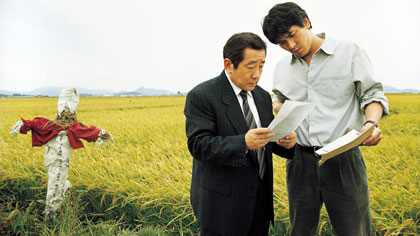
Memories of Murder
Republic of Korea 2003

Reviewed by David Jays
Synopsis
Our synopses give away the plot in full, including surprise twists.
In 1986, the local police force in a small Korean town investigates a series of murders of women. Detective Park Doo-Man (Song Kang-Ho), who works on instinct, attempts to extract a confession from village idiot Kwang-Ho (Park Noh-Sik). A younger detective, Seo Tae-Yoon (Kim Sang-Kyung), arrives from Seoul to join the floundering investigation. Kwang-Ho is released and the head of the investigative team replaced. Seo suggests that a missing woman is probably another victim; her body is subsequently discovered. Seo constructs a detailed picture of the crimes, all of which take place in the rain.
Kweon Kwi-Ok (Koh Seo-Hee), the team's only female officer, discovers a radio show that has received a request for an identical song on the day of each killing, but the caller's details have been discarded. Park, desperate to regain credibility, visits a shaman and arrests another suspicious, but innocent, suspect. Seo finds a woman who escaped the killer, and then a young man called Park Hyun-Kyu (Park Hae-Il) who arrived in the town shortly before the first murder. The interrogation of this young man is ruined by Detective Park's thuggish sidekick, and Park Hyun-Kyu is released pending DNA tests. Kwang-Ho, who witnessed one of the murders, dies in an accident before he can identify the killer, and a schoolgirl becomes the next victim. Seo tries to compel a confession from Park Hyun-Kyu, but the DNA test proves inconclusive.
In 2003, former Detective Park is now a salesman. He passes the location of the first murder, where a girl says another man recently revisited the spot.
Review
Memories of Murder is based on a series of unsolved murders that took place between 1986-91 in provincial South Korea: ten women were raped and murdered but the killer was never brought to justice. Bong Joon-Ho's remarkable film goes beyond telescoped details of the failed investigation to construct a desolate portrait of the rents in civil society. As two combative detectives - lazy local detective Park and his lean city rival Seo - clash, then gradually discard their contrasting professional principles, Bong tells a devastating story about the failures of both corruption and rigour and suggests a pessimism leeching through Korean society.
The police station is presented as a clunky old office in bleached-out grey and beige. Under a low ceiling, the air fills with smoke and a cop sticks photos of suspects in a scrapbook. The only female officer is confined to making coffee; this masculine world of snacking and petty corruption breeds negligence. The basement boiler-room is the scene of wrongheaded hardball and torture, as Park's sidekick stamps on suspects with duster-wrapped boots. A maintenance guy potters in to adjust the boiler while a near-delirious suspect struggles to fabricate an acceptable confession.
From the first, the tone is marked by incongruous comedy. Crime scenes mill into chaos as the forensics man tumbles down a slope and bystanders trample vital evidence. The camera pans over these antics until it reaches the corpse: there is a terrible sense of time being lost. Even more challenging is a gruesome cut from a corpse to the bloody meat sizzling in one of the cops' communal meals, and the tragi-farcical blunders seem increasingly less amusing. A radio station thwarts the investigation, leaving Seo standing in a slag heap of trash; as a witness seems close to identifying the murderer, he dies in a pointless train accident, leaving only his fake Nike sneaker on the line. Bong's comedy gathers dispiriting force.
The camera brings us queasily closer to atrocity. At first we see the bodies, then share a victim's point of view. We've already seen her doing domestic chores; now her torch trails uselessly through the dark fields. Finally, we share the killer's viewpoint as he considers potential victims, selecting a schoolgirl who has appeared in previous scenes. The crimes become more personal even as the prospect of arrest recedes.
Bong achieves a wonderful poker-faced absurdity. Simple-minded Kwang-Ho, hauled in for questioning, eats and watches a TV cop show with the policemen between beatings. Other bizarre details have a factual basis, including Park's visit to a shaman who gives him a charm to reveal the killer's face. It doesn't work, but Park and Seo do spot a man wanking at the murder spot, torch bobbing from his mouth. The ensuing chase releases the investigators' frustrated energy; a percussive rumble on the soundtrack accompanies the cops pelting after the perv. They eventually erupt into a weirdly busy nocturnal quarry, just one of the dislocations in mood and expectation.
The dynamic between Park and Seo is central to the film and brilliantly played. Park (droll, fleshy Song Kang-Ho) survives on instinct, planting evidence and beating out confessions. His sole attempt at deduction is to suggest the murderer lacks pubic hair, so he searches for hairless men in the sauna. He believes the FBI uses investigative techniques because the US is so large, while Korea is merely "the size of my dick and can manage without". Kim Sang-Kyung's sardonic Seo views the case as fertile territory for his investigative rigour. He rejects a prime desk for a dark corner, and prefers to peel apples on a lads' night out rather than snog or sing.
Only when they belatedly identify a probable killer do the rivals converge. This is an unassuming but implacable young man in a neat grey turtleneck. Seo is so certain of his guilt that he resents waiting for a DNA test (Korea couldn't perform DNA testing, so samples must be sent to the US). In a downpour, he manhandles the youth to a railway tunnel and threatens him with the first gun we've seen - previous police brutality has been administered the old-fashioned way. When Park arrives with inconclusive DNA results, Seo's bloodied hands clutch the letter as he snarls, "The document is a lie. I don't need it." The suspect, his smooth face mocking, totters up the tunnel as Seo shoots and misses. Seo hurls away his principles and still fails: it's a devastating, inconsolable finale.
The atmosphere of Memories of Murder settles like a mist. In this dank, provincial autumn, greys and beiges infect the green of the rice and cabbage fields, and a victim's red clothes seem to darken lifelessly in the film's muddy palette. Only the present-day coda introduces blue skies and golden fields. Park now only uses his old techniques to quiz his son about homework. We leave him, haunted by the unsolved case: the film ends with him staring, perplexed and greying, into the camera.
These murders tapped into South Korea's collective fantasies and paranoia. We see civil defence drills, crackdowns on dissent (cops are unavailable for an important operation because they're off suppressing a demonstration) and zealously enforced blackouts: shop shutters descend, lights disappear during the last murder, stressing the detectives' despairing impotence. Building into a portrait of a society displaying its fractures and fears, a corrosive suspicion of its own institutions, Bong's unpredictable comedy becomes a sombre, forensic examination of failure.
Credits
- Director
- Bong Joon-Ho
- Producer
- Kim Moo-Ryung
- Screenplay
- Bong Joon-Ho
- Shim Sung-Bo
- Based on the story Nal borer Wayo [Come and See Me]
- by Kim Kwang-Rim
- Director of Photography
- Kim Hyoung-Gu
- Editor
- Kim Sun-Min
- Production Designer
- Ryu Sung-Hee
- Music/Orchestration/ Conducted by
- Taro Iwashiro
